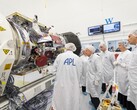A recent study from UAE University examines using antimatter as a new way to power spaceships, which could influence the future of space travel. Published in the International Journal of Thermofluids, the research explores the idea that antimatter-powered engines might make interstellar journeys possible during a single human lifetime—something that’s been more of a sci-fi dream until now.
The study investigates antimatter’s incredible energy potential—about 9 × 10¹⁶ joules per kilogram, released with 100 percent efficiency when antimatter meets regular matter. Of that energy, about 70 percent can be used to propel a spacecraft forward, making it way more efficient than any current propulsion technology.
In perspective, just 1 gram of antihydrogen reacting with regular hydrogen would generate enough energy to power 23 space shuttles. That’s a power boost about 10 billion times stronger than traditional hydrogen-oxygen combustion and roughly 300 times more intense than the fusion reactions in the Sun’s core.
But it’s not all smooth sailing—there are some enormous challenges. First, making and storing antimatter is incredibly tricky. Places like CERN’s particle accelerators can only make about 10 nanograms of antimatter a year, costing millions of dollars.
Then there’s the storage problem. Since antimatter and normal matter annihilate each other on contact, antimatter has to be stored in a vacuum using powerful electromagnetic traps. Even with the best setups today, we’ve only managed to keep antimatter contained for about 16 minutes—not exactly ideal for space missions.
The research also looks at some potential engine designs:
- Beam Core Systems: These could hit speeds with specific impulses up to 10 million meters per second by shooting charged particles through magnetic nozzles.
- Plasma Core Systems: A solid mix of efficiency and power, these engines might make solar system travel take days or weeks instead of years.
- Gas Core and Solid Core Systems: These deliver more thrust but don’t go as far, making them better for shorter trips.
Aside from being powerful, antimatter engines could also be better for the environment. Unlike rockets that rely on regular fuel or nuclear power, they wouldn’t produce carbon emissions or radioactive waste. Still, scaling up the tech is a huge “what if” at this point.
The researchers are hopeful that with enough time and effort, we’ll eventually figure out how to produce and store antimatter more efficiently. While we’re a long way from practical use, this technology could someday open the door to space travel as we’ve never imagined—letting us explore distant stars that current propulsion systems can’t even dream of reaching.
Source(s)
TechSpot (in English)





















